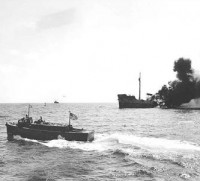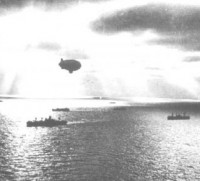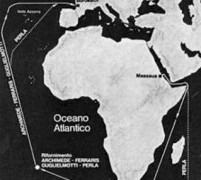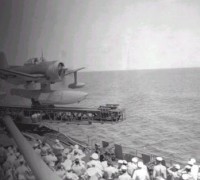- COMMANDER SOUTH ATLANTIC
20)OPERATIONS FEBRUARY 1943
Apparently no submarines were destroyed during February, though many an encounter took place, followed in several cases by attacks. A brief review of the month's record will show the increasing importance of the Brazilian Navy and Air Force in the Battle of the South Atlantic.
On February 5, the Carioca attacked a hostile submarine, at Latitude 09° 03' S, Longitude 34° 45' W, with results that appeared negative. Four days later, a surface escort of a Bahia-Trinidad Convoy made a second attack at Equator, 45° 08' W, with no apparent success. On the 10th, the CS-1, also Brazilian, left Bahia to investigate a submarine reported sighted by the FAB at 13° 20' S, 38° 40' W. The ship made a good sound contact and dropped five depth charges, again with no evidence of results.
February 14 saw three contacts made. The first two, which may have involved the same submarine, were sighted by an American and a Brazilian plane respectively. The first pilot, belonging to VP-83, saw his submarine at 08° 25' S, 34° 35' W, but did not attack. About two hours later, the FAB pilot delivered an attack on a U-Boat very near the position of the first sighting. Still later, the Carioca tangled with a submarine somewhat farther to the south, with no visible success.
The day following, still in the same vicinity, PC-489, forming part of a Bahia-Trinidad convoy, heard a torpedo and then a submarine. The sound contact was good; three attacks were delivered, with results again estimated as negative. The proximity of this to the previous day's events suggests that the sub was one of those then involved and that it was definitely after the convoy.
On the 17th, HMS Wastwater, a ship not belonging to the South Atlantic Force, attacked a stationary sound contact at 07° 07' S, 34° 15' W. Again there was no evidence of results. A few hours later, a U. S. Army B-24 plane, flying at an altitude of 9,500 feet, was fired on by a submarine. This encounter took place well east of the Wastwater's attack; hence he assailant must have been a different sub. The plane escaped without injury, but, having no equipment for attack, merely flew on and reported the incident.
Next day a submarine sank the Brazilian merchant vessel Brasiloide at 12° 47' S, 37° 33' W. Some hours afterward, a Condor plane sighted a U-Boat in a position that could have made it the Brasiloide's attacker. The Destroyer Kearney was at once ordered out of Base Baker (Bahia) to hunt and destroy the submarine. Aircraft from VP-83 and VP-94, several planes from the Santee and one from the Memphis helped track the enemy. The FAB, on request, also supplied some assistance. In spite of the exceptional effort made, all searchers came back empty handed.
In one day, the 24th, the Carioca reported two contacts, which she followed up with a fruitless attack at 09° 58' S, 35° 39' W. Some hours earlier, a plane of VP-83 reported seeing a submerged submarine attack a ship at 04° 46' S, 31° 55' W. The plane made straight for the enemy, which surfaced immediately after its attack on the vessel. The pilot dropped four depth charges, which fell short, inflicting no apparent damage. The U-Boat resubmerged, but not until it had fired at the plane, and a little later surfaced again about six miles away. While all this went on, the attacked vessel sank, being later identified as the Spanish ship Monte Igueldo.
The Humboldt and Kearney, then in Recife, were both ordered out to hunt the sub. They failed to locate it, but in the meantime a VP-83 plane sighted the Spanish freighter El Saturno, a ship strongly suspected of unneutral practice and of carrying contraband. The Humboldt and Kearney, being nearby while engaged in their sub hunt, were directed to order El Saturno into Recife for search, provided such action did not interfere with their primary mission. Apparently it did, since it was a plane that ordered the Spanish ship to reverse its course and proceed under surveillance to Recife. In the meantime the two warships went on with their fruitless search.
As El Saturno neared the Brazilian port the Commander South Atlantic Force learned from the Ministro de Marinha that the United States could not search her inside the continental limits of Brazil. Consequently, a searching party was sent out in the Linnet to board El Saturno, which meanwhile had anchored about three miles off Recife. The searchers went through the ship's papers, examined the crew, and looked through quarters. No evidence of unneutral service appeared, so they released the vessel.
The Spanish captain immediately proceeded into Recife for coal. Within a few days he insisted that the U. S. Navy should reimburse him for the fuel he had consumed as a result of being diverted. Before the Spanish Consul could proffer a formal request, the American Naval Authorities asked the Vice Chief of Naval Operations for instructions in the matter. The reply from Washington said that no such reimbursement would be made, but did state that El Saturno should be aided in obtaining any necessary fuel and supplies.
Earlier in the month, to illustrate the amount of trouble Spanish merchant vessels often gave, an order went out to ocean patrols to seize the ship Monte Naranco (Spanish), should she be encountered. Then, should search indicate unneutral service as anticipated, the patrol should bring her to the nearest neutral port for adjudication. The Monte Naranco was not encountered, nor were all Spanish ships engaged in unneutral service. However, the chances that they might be up to something were for a long time considered good grounds for treating any ship under the flag of Spain as an object of suspicion.
During February, two important forthcoming developments were announced, though they did not materialize until a little later. On the 11th, NOB Rio was requested by despatch to inform the appropriate Brazilian government officials and the U. S. Embassy of a contemplated expansion of Navy personnel and facilities at Natal. Within a short time Fleet Air Wing Sixteen would be installed in Brazil, and at that time Natal seemed the logical place for headquarters.
Then, on February 20, news arrived of an impending change that many believed to be somewhat overdue. The Commander-in-Chief, U. S. Fleet, sent word that the South Atlantic Force would become the Fourth Fleet. Its new status should date from the 15th of March. The despatch from Cominch furthermore said that from that time the entire U. S. Fleet would comprise numbered Fleets. Within these units Task Force organizations were to conform to numbers at that time being allocated. Those assigned to the Task Forces of the Fourth Fleet should run from forty to forty nine.
Hyper War. Commander South Atlantic Force. U.S Naval Administration in WW II.



